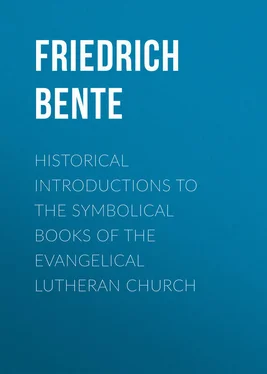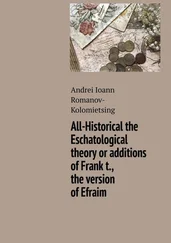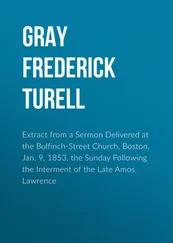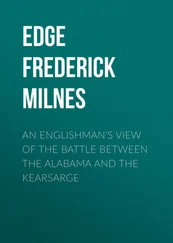Friedrich Bente - Historical Introductions to the Symbolical Books of the Evangelical Lutheran Church
Здесь есть возможность читать онлайн «Friedrich Bente - Historical Introductions to the Symbolical Books of the Evangelical Lutheran Church» — ознакомительный отрывок электронной книги совершенно бесплатно, а после прочтения отрывка купить полную версию. В некоторых случаях можно слушать аудио, скачать через торрент в формате fb2 и присутствует краткое содержание. ISBN: , Жанр: foreign_antique, foreign_prose, на английском языке. Описание произведения, (предисловие) а так же отзывы посетителей доступны на портале библиотеки ЛибКат.
- Название:Historical Introductions to the Symbolical Books of the Evangelical Lutheran Church
- Автор:
- Жанр:
- Год:неизвестен
- ISBN:http://www.gutenberg.org/ebooks/26909
- Рейтинг книги:3 / 5. Голосов: 1
-
Избранное:Добавить в избранное
- Отзывы:
-
Ваша оценка:
- 60
- 1
- 2
- 3
- 4
- 5
Historical Introductions to the Symbolical Books of the Evangelical Lutheran Church: краткое содержание, описание и аннотация
Предлагаем к чтению аннотацию, описание, краткое содержание или предисловие (зависит от того, что написал сам автор книги «Historical Introductions to the Symbolical Books of the Evangelical Lutheran Church»). Если вы не нашли необходимую информацию о книге — напишите в комментариях, мы постараемся отыскать её.
Historical Introductions to the Symbolical Books of the Evangelical Lutheran Church — читать онлайн ознакомительный отрывок
Ниже представлен текст книги, разбитый по страницам. Система сохранения места последней прочитанной страницы, позволяет с удобством читать онлайн бесплатно книгу «Historical Introductions to the Symbolical Books of the Evangelical Lutheran Church», без необходимости каждый раз заново искать на чём Вы остановились. Поставьте закладку, и сможете в любой момент перейти на страницу, на которой закончили чтение.
Интервал:
Закладка:
Among the later noteworthy editions of the Book of Concord are the following: Tuebingen 1599; Leipzig, 1603, 1622; Stuttgart 1660, 1681. Editions furnished with introductions or annotations or both: H. Pipping, 1703; S.J. Baumgarten, 1747; J.W. Schoepff, Part I, 1826, Part II, 1827; F.A. Koethe, 1830; J.A. Detzer, 1830; F.W. Bodemann, 1843. In America the entire Book of Concord was printed in German by H. Ludwig, of New York, in 1848, and by the Concordia Publishing House of St. Louis, Mo., in 1880. In Leipzig, Latin editions appeared in the years 1602, 1606, 1612, 1618, 1626, 1654, 1669, 1677. Adam Rechenberg's edition "with an appendix in three parts and new indices" ( cum appendice tripartita et novis indicibus ) saw five editions – 1678, 1698, 1712, 1725, 1742. We mention also the edition of Pfaffius, 1730; Tittmann, 1817; H.A.G. Meyer, 1830, containing a good preface; Karl Hase, in his editions of 1827, 1837, and 1845, was the first to number the paragraphs. Reineccius prepared a German-Latin edition in 1708. This was followed in 1750 by the German-Latin edition of Johann Georg Walch. Mueller's well-known German-Latin Concordia saw eleven editions between 1847 and 1912. Since 1907 it appears with historical introductions by Th. Kolde.
4. English Translations
All of the Lutheran symbols have been translated into the English language repeatedly. In 1536 Richard Tavener prepared the first translation of the Augsburg Confession. Cranmer published, in 1548, "A Short Instruction into the Christian Religion," essentially a translation of the Ansbach-Nuernberg Sermons on the Catechism. In 1834 a translation of the German text of the Augsburg Confession with "Preliminary Observations" was published at Newmarket, Va., by Charles Henkel, Prof. Schmidt of the Seminary at Columbus O., assisting in this work. The Introduction to the Newmarket Book of Concord assigns Henkel's translation of the Augsburg Confession to the year 1831. Our copy, however, which does not claim to be a second edition, is dated 1834. In his Popular Theology of 1834, S.S. Schmucker offered a translation of the Latin text, mutilated in the interest of his American Lutheranism. Hazelius followed him with a translation in 1841. In 1848, Ludwig, of New York, issued a translation of the German text of the Unaltered Augsburg Confession, as well as of the Introduction, prepared by C.H. Schott, together with the Ecumenical Symbols, also with introductions. The title-page of our copy lists the price of the book at 12 1/2 cents. C.P. Krauth's translation of the Augsburg Confession appeared in 1868. The first complete translation of the German text of the entire Book of Concord was published in 1851 by the publishing house of Solomon D. Henkel & Bros., at Newmarket, Va. In this translation, however, greater stress was laid on literary style than upon an exact reproduction of the original. Ambrose and Socrates Henkel prepared the translation of the Augsburg Confession, the Apology, the Smalcald Articles, the Appendix, and the Articles of Visitation. The Small Catechism was offered in the translation prepared by David Henkel in 1827. The Large Catechism was translated by J. Stirewalt; the Epitome, by H. Wetzel; the Declaratio, by J.R. Moser. The second, improved edition of 1854 contained a translation of the Augsburg Confession by C. Philip Krauth, the Apology was translated by W.F. Lehmann, the Smalcald Articles by W.M. Reynolds, the two Catechisms by J.G. Morris, and the Formula of Concord together with the Catalogus by C.F. Schaeffer. In both editions the historical introductions present a reproduction of the material in J.T. Mueller's Book of Concord.
In 1882 a new English translation of the entire Book of Concord, together with introductions and other confessional material, appeared in two volumes, edited by Dr. H.E. Jacobs. The first volume of this edition embraces the confessional writings of the Lutheran Church. It contains C.P. Krauth's translation of the Augsburg Confession as revised for Schaff's Creeds of Christendom. Jacobs translated the Apology (from the Latin, with insertions, in brackets, of translations from the German text), the Smalcald Articles (from the German), the Tractatus (from the Latin), and the Formula of Concord. The translation of the Small Catechism was prepared by a committee of the Ministerium of Pennsylvania. The Large Catechism was done into English by A. Martin. A reprint of this edition appeared in 1911, entitled "People's Edition," in which the Augsburg Confession is presented in a translation prepared by a committee of the General Council, the General Synod, the United Synod in the South, and the Ohio Synod. The second volume of Jacobs's edition of the Book of Concord embodies historical introductions to the Lutheran symbols, translations of the Marburg Articles, the Schwabach Articles, the Torgau Articles, the Altered Augsburg Confession of 1540 and 1542, Zwingli's Ratio Fidei, the Tetrapolitana, the Romish Confutatio, Melanchthon's Opinion of 1530, Luther's Sermon on the Descent into Hell of 1533, the Wittenberg Concordia, the Leipzig Interim the Catalogus Testimoniorum, the Articles of Visitation, and the Decretum Upsaliense of 1593. The Principles of Faith and Church Polity of the General Council and an index complete this volume. A Norwegian and a Swedish translation of the Book of Concord have also been published in America.
5. Corpora Doctrinae Supplanted by Book of Concord
More than twenty different Lutheran collections of symbols or corpora doctrinae (a term first employed by Melanchthon), most of them bulky, had appeared after the death of Luther and before the adoption of the Formula of Concord, by which quite a number of them were supplanted. From the signatures to its Preface it appears that the entire Book of Concord was adopted by 3 electors, 20 princes, 24 counts, 4 barons, and 35 imperial cities. And the list of signatures appended to the Formula of Concord contains about 8,000 names of theologians, preachers, and schoolteachers. About two-thirds of the German territories which professed adherence to the Augsburg Confession adopted and introduced the Book of Concord as their corpus doctrinae. (Compare Historical Introduction to the Formula of Concord.)
Among the corpora doctrinae which were gradually superseded by the Book of Concord are the following: 1. Corpus Doctrinae Philippicum, or Misnicum, or Wittenbergense of 1560, containing besides the Three Ecumenical Symbols, the following works of Melanchthon: Variata, Apologia, Repetitio Augustanae Confessionis, Loci, Examen Ordinandorum of 1552, Responsio ad Articulos Bavaricae Inquisitionis, Refutatio Serveti. Melanchthon, shortly before his death, wrote the preface for the Latin as well as the German edition of this Corpus. 2. Corpus Doctrinae Pomeranicum of 1564 which adds Luther's Catechisms, the Smalcald Articles, and three other works of Luther to the Corpus Doctrinae Philippicum, which had been adopted 1561. 3. Corpus Doctrinae Prutenicum, or Borussicum, of Prussia, 1567, containing the Augsburg Confession, the Apology, the Smalcald Articles, and Repetition of the Sum and Content of the True, Universal Christian Doctrine of the Church, written by Moerlin and Chemnitz. 4. Corpus Doctrinae Thuringicum in Ducal Saxony, of 1570, containing the Three Ecumenical Symbols, Luther's Catechisms, the Smalcald Articles, the Confession of the Landed Estates in Thuringia (drawn up by Justus Menius in 1549), and the Prince of Saxony's Book of Confutation ( Konfutationsbuch ) of 1558. 5. Corpus Doctrinae Brandenburgicum of 1572, containing the Augsburg Confession according to the Mainz Manuscript, Luther's Small Catechism, Explanation of the Augsburg Confession drawn from the postils and doctrinal writings "of the faithful man of God Dr. Luther" by Andreas Musculus, and a Church Agenda. 6. Corpus Doctrinae Wilhelminum of Lueneburg, 1576, containing the Three Ecumenical Symbols, the Augsburg Confession, the Apology, the Smalcald Articles, Luther's Catechisms, Formulae Caute Loquendi (Forms of Speaking Cautiously) by Dr. Urbanus Regius, and Formulae Recte Sentiendi de Praecipuis Horum Temporum Controversiis (Forms of Thinking Correctly concerning the Chief Controversies of These Times) by Martin Chemnitz. 7. Corpus Doctrinae Iulium of Duke Julius of Braunschweig-Wolfenbuettel, 1576, containing the documents of the Wilhelminum, with the sole addition of the Short Report of Some Prominent Articles of Doctrine, from the Church Order of Duke Julius, of 1569. 8. The Hamburg Book of Confession of 1560, which was also adopted by Luebeck and Lueneburg, and contained a confession against the Interim drawn up by Aepinus in 1548, and also four declarations concerning Adiaphorism, Osiandrism, Majorism, and the doctrine of the Lord's Supper, drawn up since 1549. 9. The Confessional Book of Braunschweig, adopted in 1563 and reaffirmed in 1570, containing, The Braunschweig Church Order of 1528, the Unaltered Augsburg Confession, the Apology thereof, the Smalcald Articles, Explanation, etc., drawn up at Lueneburg in 1561 against the Crypto-Calvinists. 10. The Church Order of the city of Goettingen 1568, containing the Church Order of Goettingen of 1531, Luther's Small Catechism, the Smalcald Articles, the Augsburg Confession, and the Apology. (Tschackert, l. c. , 613f.; Feuerlinus, l. c. , 1f.)
Читать дальшеИнтервал:
Закладка:
Похожие книги на «Historical Introductions to the Symbolical Books of the Evangelical Lutheran Church»
Представляем Вашему вниманию похожие книги на «Historical Introductions to the Symbolical Books of the Evangelical Lutheran Church» списком для выбора. Мы отобрали схожую по названию и смыслу литературу в надежде предоставить читателям больше вариантов отыскать новые, интересные, ещё непрочитанные произведения.
Обсуждение, отзывы о книге «Historical Introductions to the Symbolical Books of the Evangelical Lutheran Church» и просто собственные мнения читателей. Оставьте ваши комментарии, напишите, что Вы думаете о произведении, его смысле или главных героях. Укажите что конкретно понравилось, а что нет, и почему Вы так считаете.












